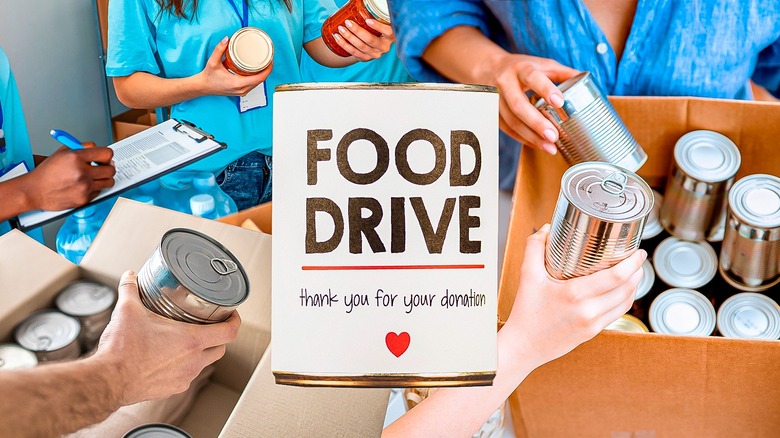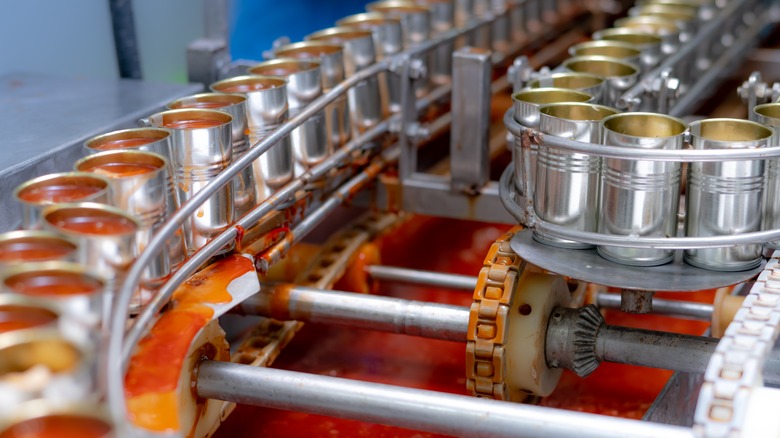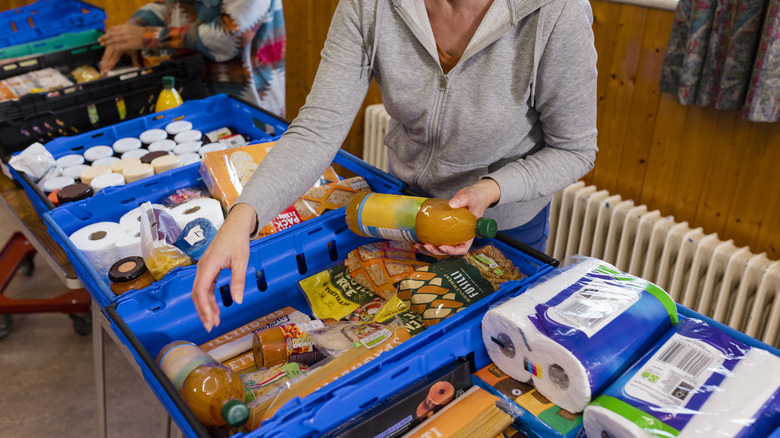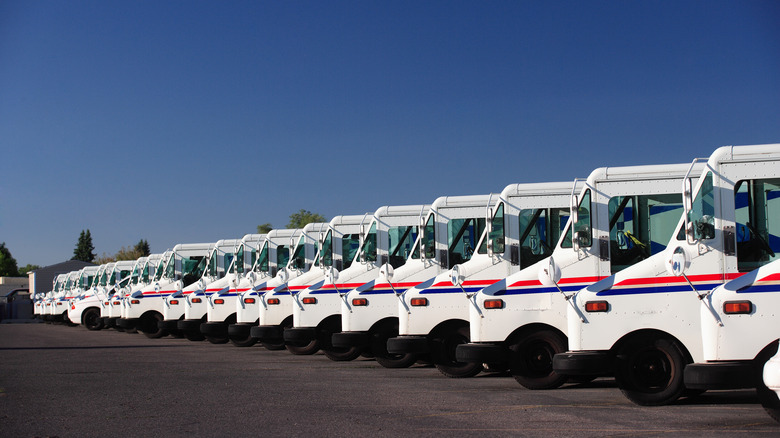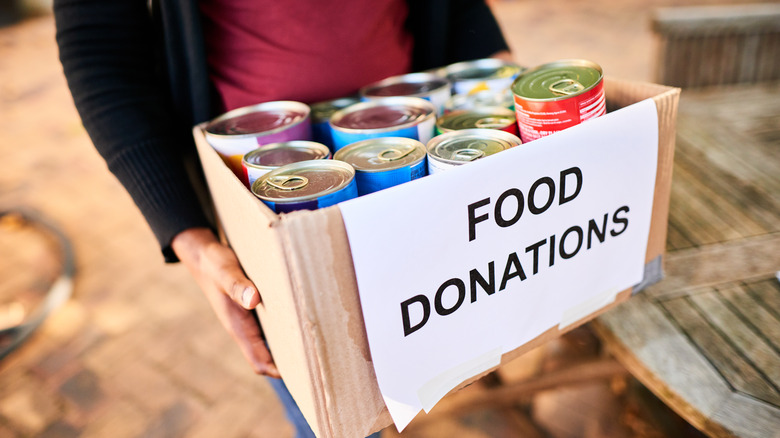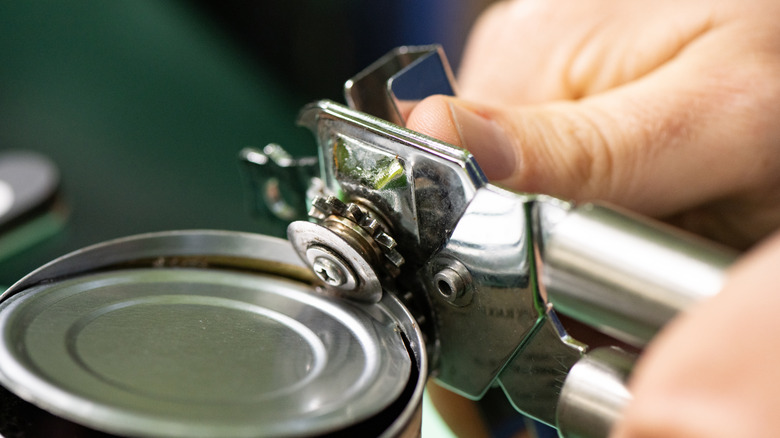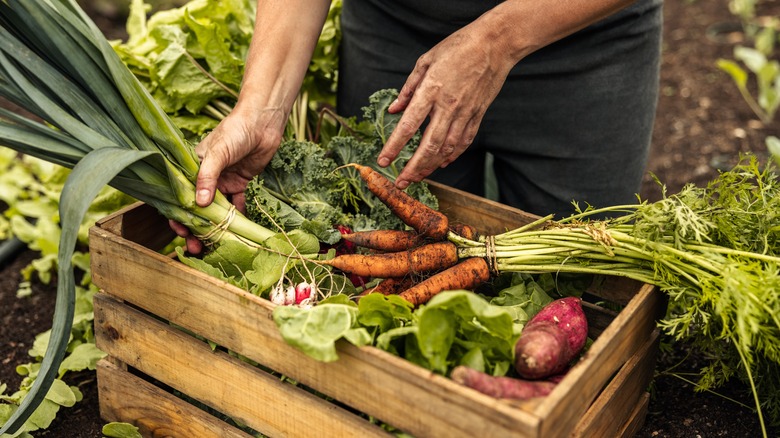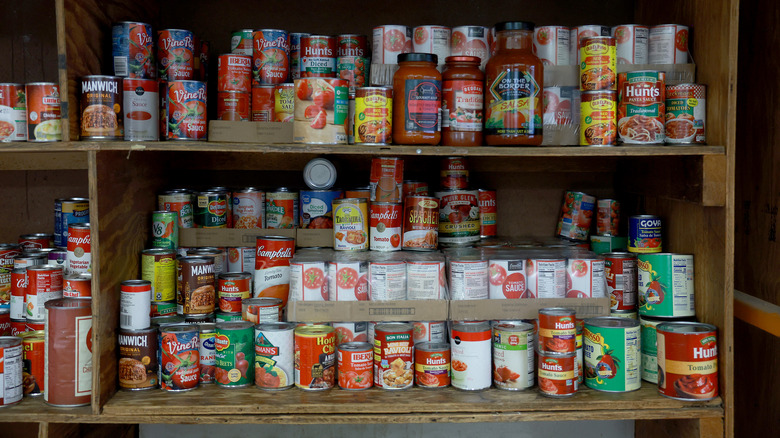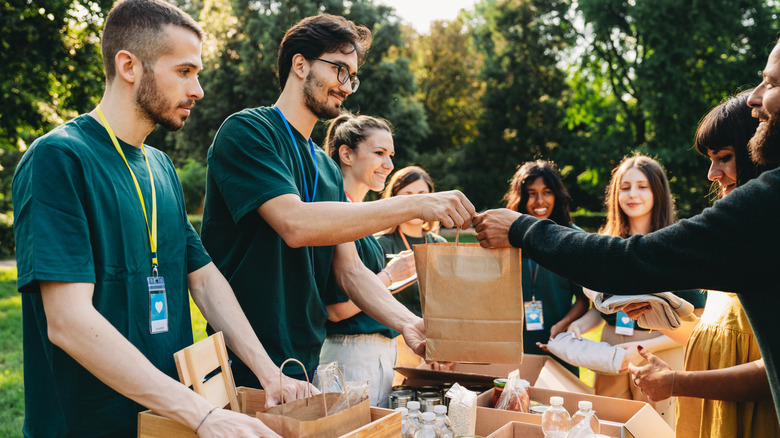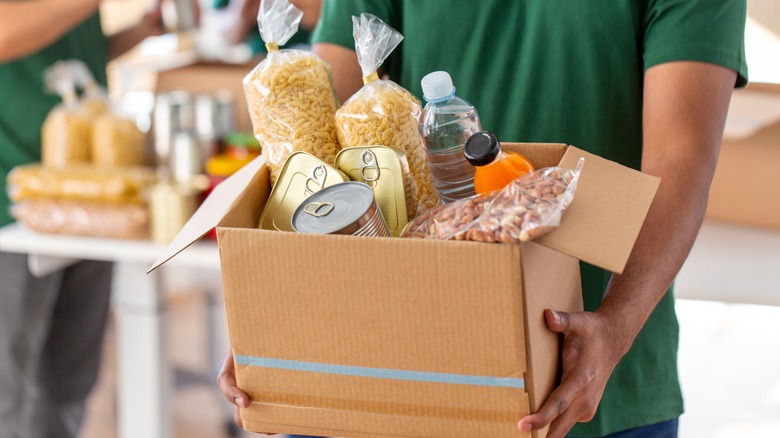12 Facts You Should Know About Canned Food Drives
All year long, the pressure to produce tables heaving with rich celebratory foods and loved ones gathered around can feel overwhelming for anyone, but it can be insurmountable for individuals already struggling to make ends meet. Organizations big and small, up and down the country, host community canned food drives to support those in need and provide temporary relief at times when it might be needed most. With food bank usage at an all-time high across the U.S., "every little bit helps" rings true more than ever.
Canned food drives can make a significant impact in communities. Their efforts can help to restock diminished supplies of overstretched food banks or community pantries and can be put directly into the hands of those who need it most. Though now considered a cultural norm in the United States, the foundations of American canned food drives and food banks are still in their relative infancy. Read on to learn how canned food drives came to fruition and how you can help make the most impact in your community by hosting a canned food drive this holiday season.
Industrial food canning came to the U.S. in the 1800s
It's hard for many of us to even imagine life before the convenience of canned foods, with many of our staple ingredients sitting in our cupboards, all thanks to shelf-stable technology. It wasn't until the 1800s that this convenience, now taken for granted, became a widespread option.
Households have inventor Nicolas Appert, known as the "father of canning," to thank for our ability to have a warm bowl of chicken noodle soup or a tuna fish sandwich on the table in minutes. Canned goods were initially designed with the military in mind. In the late 1700s, the French government offered a reward for anyone who could create a way to make cheap, non-perishable goods for the country's army and navy. Appert won the award with his air-tight corked and sealed wax glass jars. Those gave way to tin and eventually can-openers, thanks to Philippe de Girard and then Robert Ayars, who brought the technology stateside in 1812. In the late 1800s, canned food became a wartime staple.
Once considered a status symbol in Europe, many households now keep a range of essential canned ingredients, from tomatoes to beans to corn, available for daily usage.
Food-based non-profits started in the 1960s
Though helping those in need is a pillar within many global religions, it wasn't until after World War II that food-focused charitable organizations appeared in the United States. St. Mary's Food Bank Alliance, the first of its kind, was opened in 1967 by John van Hengel. The organization sought to help repurpose excess food that would otherwise be wasted, including products from the commercial food industry. In 1976, van Hengel opened a second organization, Second Harvest, which ultimately became the invaluable network known as Feeding America.
When establishing St. Mary's Food Bank Alliance, little did van Hengel know that he would help create the structure of a network now over 200 food banks and 60,000 meal programs strong. Feeding America is the largest network of food banks in the United States, with other food pantries and banks established outside the network.
Food bank usage has never been as high as it is today, both in the U.S. and the U.K., compounded by factors including the dramatic rise in the cost of everything from gas to groceries, coupled with the funding cuts to programs like SNAP (Supplemental Nutrition Assistance Program), a government-sponsored subsidized food program that supports over 41 million consumers. As of 2020, there are over 300 food banks on record across the U.S.
Postal workers are at the heart of community food service
Not enough credit is given to the hardworking folks of the U.S. Postal Service. Not only are they a force who deliver everything we need right to our doorsteps six days a week through all kinds of weather, but they have also been the beating heart of the nation's canned food drives since the early '90s.
The NALC (National Association of Letter Carriers) hosted its first canned food drive in 1991 in 10 cities. It was such a success that the NALC soon put plans into place to expand its reach. In 1993, the first nationwide NALC drive took place across all 50 states, with letter carriers collecting more than 11 million pounds of food in just one day along their routes. We can only imagine how sore the arms of the letter carriers must have been!
The annual drive is now part and parcel, raising approximately 1.9 billion pounds of food over the last 30 years — something to think about the next time you're waiting for a package or drive past the post person, dutifully delivering the mail.
There are a few items you shouldn't donate at your local food drive
Many of the canned and non-perishable food items in your pantry and at your local grocery store are highly versatile and valuable for food drives, but there are also items that food banks and their recipients cannot use for a variety of reasons.
Though often acceptable if the dents are minimal, dented cans and cans with broken seals still pose the risk of spoiled food and harmful bacteria inside and, therefore, should remain out of your donation box (and you should think twice before consuming them yourself). Glass jars are also often discouraged, as they can easily break and shatter during transportation. Likewise, perishable items from produce to dairy, homemade foods, or partially used ingredients are also discouraged due to health and safety concerns.
Lastly, large bulk foods like commercial sacks of flour, rice, or tins of beans are also often discouraged, as their ability to be repacked into smaller, family-sized portions might not be possible depending on the food bank or organization sponsoring the canned food drive.
A most wanted list increases the impact of food drives
There are many ways and opportunities to give back to your community, from volunteering your time to donating goods or funds to organizations that support those in need. If you are one of the many helping to organize a food drive for your business, school, or place of worship, checking with the local food banks is highly recommended to maximize the drive's impact. Generally, most food banks will have a surplus of some items and a deficit of others, which can change from season to season and vary based on the needs of the communities they serve. While any donation is certainly appreciated, providing what the food bank needs the most ensures they can help more people.
After liaising with the food banks to understand what items are in short supply, adding a "most wanted" list for your food drive can help direct the efforts of those donating, making sure to generate the most impact. These items range from pasta and sauces to peanut butter, canned fruits and vegetables, and proteins like chicken or beans.
Consider donating resources for opening, heating, and eating
When donating to your local canned food drive (or hosting one yourself), it's essential to consider all aspects of cooking and eating. This includes access to heat sources like stoves, ovens, hot plates, or microwaves. Further, will the food drive recipient need a can opener, a sharp knife, utensils, or pots and pans to use the donated food? It's okay if some of these items are needed for the collected food, but considering all types of accommodations can help make the drive as inclusive as possible, serving people in a wide range of circumstances.
If specific tools are needed to take items from boxed or canned to being ready-to-eat, donating can openers, utensils, or cooking equipment can go a long way towards ensuring someone has access to food regardless of living arrangements. Likewise, donating foods that require minimal cooking, equipment, and tools and can be eaten cold, either as meals or snacks, helps to ensure anyone and everyone can make good use of the items.
Including treats can make a real impact
It's a fact that humans everywhere, no matter what type of living circumstances, love a treat every now and again. Treats and rewards of all kinds can boost dopamine levels in our brains, creating feelings of happiness, self-confidence, and self-compassion — feelings that benefit absolutely everyone.
While food banks and canned food drives are helpful resources in meeting the essentials, adding a few non-necessities, like little treats for children, can go a long way towards helping someone on a different, yet equally meaningful level, especially during a time of year when gifts, treats, and luxuries take center stage.
Adding individually packaged candies, seasonal treats like candy canes, cookies, or potato chips, and boxed cake mixes with tubs of frosting and candles can go a long way toward increasing feelings of joy especially around the holidays and special occasions like birthdays. You could also consider tucking in non-food items like coloring books with crayons, nice-smelling shampoos, hand creams, or other toiletries that can be both functional and luxurious. Considering the human desire for feel-good moments that go beyond the basics can make a real impact on the lives of others, around the holidays or any time of year.
Farmers across the U.S. are now partnering with food banks
It isn't just the work of canned food drives that support food banks in delivering nourishing and necessary goods to help those in need. Farmers across the U.S. are also getting involved, helping to extend the resources of food banks to include fresh foods, too.
The Emergency Food Assistance Program (TEFAP) is a program through the United States Department of Agriculture that supports farmers by buying their crops and then distributing them to food banks to provide to clients. In 2020, this translated to approximately 1.7 billion meals provided to Feeding America using the fresh foods grown and purchased through this program. There are also organizations like Hunger Task Force, a 208-acre farm in a suburb of Milwaukee, Wisconsin, that grows half a million pounds of fresh foods and vegetables each year for their local food banks, distributed to local Milwaukee residents who need extra support.
These partnerships aren't unique to the U.S. — they're happening around the world, with organizations like Global Generation in London, which uses a portion of its urban-based community garden beds to grow food to support the local food bank.
Many schools host free pantries for families in need
Another way to help your community is to consider hosting a canned food drive for your local school. Not just for food banks, canned food drives are also a fantastic way to restock school pantries reserved for local students and families in need. School-based free pantries have become more common in recent years and can be a tremendous asset to the families of students who may not know where else to turn for additional support.
Many school-based pantry programs tailor the items offered to help support healthy food habits. This focus can benefit students using the pantries, helping support better focus and learning, more energy for physical activity, and education about the benefits of nutritious foods. The healthier, better-fed, and more supported the whole student body feels, the healthier and happier the school community feels. This can also help students and families develop a closer relationship with educational systems, assisting the children in remaining in school, reducing feelings of isolation and loneliness, and lending itself to positive long-term results.
Food scarcity has become apparent across college campuses
Not just reserved for grade school-aged children and families, college campuses have also been rolling out more free food-based resources as the need to help students of all ages grows. These offerings can range from providing essential kitchen equipment with student accommodations in mind to education, classes, and food.
According to the 2020 National Postsecondary Student Aid Study, one out of every five U.S.-based undergrads are food insecure, partially due to difficulties students face in qualifying for SNAP as well as the impacts of COVID-19. These statistics include working students, too, with many attempting to offset their student debt with low-paying jobs typical for this age group.
This growing body of hungry students has driven the need for campuses nationwide to act. Campus-based free food pantries are more present than ever, having grown from 80 to an estimated 800 over the last decade.
Non-profit organizations like Swipe Out Hunger help over 140 college and university-based food pantries to work together by providing ongoing support, consultation, tools, and resources, helping college students everywhere have their basic needs met so that they can focus on the future. Supporting a canned food drive at your local college or university campus can work towards making a significant impact in supporting the next generation of leaders.
Food banks also need money to help fix the bigger issues
While food-based solutions like canned food drives are necessary for providing immediate support and relief to those in need, they are just one of the many steps needed to eradicate hunger for good. In the current state of increased costs, food banks are also feeling the strain and stretch for resources. Reliant on donations, food banks are reporting that many shoppers who might usually donate are finding themselves short on extra money. Supply chain issues are affecting the amount of economically priced resources available for food banks and the charity's budgets, which once just covered all the supplies needed are now falling short, due to the rising costs of food.
This means not only do food banks need support via canned food drives to help share costs, but they also need additional funding. Funding is not just for food, it also goes towards means of support focusing on more long-term solutions, including job retraining, mental health support, and other services that can help move individuals away from crisis and the cycle of poverty altogether.
Temporary and permanent solutions are necessary
Though food-based solutions aren't equipped to tackle the broader causes of food insecurity, such as low wages, access to healthcare, and systemic inequalities, resources like canned food drives and food banks are still a necessary stop-gap while larger problems are being addressed. After all, the United States Department of Agriculture Household Food Security Report for 2022 showed that the number of food-insecure households in the U.S. reached 44 million and is on the rise.
Thankfully, it's never been easier to donate to the cause. Grocery delivery company Instacart now has a donation feature called "community carts," which allows customers to directly donate requested grocery items to around 100 food banks across the country every time they place an order through the organization Feeding America, which works with hundreds of food banks.
For those who aren't able to find a local canned food drive in their area, this is an easy solution, providing those who are financially able with access to help others in need this holiday season.
